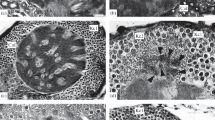Abstract
Mushroom bodies are developed similarly in all the carrion beetles studied, and the transition from necrophagy to predation in some species does not affect considerably their level of development. The Kenyon cells form two small groups in each brain hemisphere and are subdivided into central and peripheral cells. Two closely located inputs of the Kenyon cell processes enter a single, pillow-shaped calyx region. The pedunculus comprises two shafts along a considerable part of its length, which fuse in the lobes. In the degree of development, the mushroom bodies of carrion beetles resemble those of basal lamellicorn and longhorned beetles.
Similar content being viewed by others
References
Bartlett, J., “Evidence for a Sex Attractant in Burying Beetles,” Ecol. Entomol. 12, 471–472 (1987).
David, J. and Bouletreau, M., “Contribution à l’etude de la biologie et de l’ecologie d’un Coleoptère entomophage Xylodrepa quadripunctata (Screb) (Silphidae),” Bul. Mens. Soc. Linn. Lyon 37(2), 73–83 (1968).
Haberer, W., Schmitt, T., Peschke, K., et al., “Ethyl 4-Methyl Heptanoate: a Male Produced Pheromone of Nicrophorus vespilloides,” J. Chem. Ecol. 34, 94–98 (2008).
Heymons, R. and von Lengerken, H., “Studien über die Lebenserscheinungen der Silphini (Coleopt.). IX. Silpha carinata L.,” Z. Morphol. Ökol. Tiere 25, 534–548 (1932).
Heymons, R. and von Lengerken, H., “Studien über die Lebenserscheinungen der Silphini (Coleopt.). X. Silpha tristis Illig.,” Z. Morphol. Ökol. Tiere 28, 469–479 (1934).
Heymons, R., von Lengerken, H., and Bayer, M., “Studien über die Lebenserscheinungen der Silphini (Coleopt.). III. Xylodrepa quadripunctata L.,” Z. Morphol. Ökol. Tiere 10, 330–352 (1928).
Ikeda, H., Kubota, K., Kagaya, T., and Abe, T., “Flight Capabilities and Feeding Habits of Silphine Beetles: are Flightless Species Really ‘Carrion Beetles’?” Ecol. Res. 22, 237–241 (2007).
Ikeda, H., Kagaya, T., Kubota, K., and Abe, T., “Evolutionary Relationships among Food Habit, Loss of Flight, and Reproductive Traits: Life-History Evolution in the Silphinae (Coleoptera: Silphidae),” Evolution 62(8), 2065–2079 (2008).
Kalinová, B., Podskalská, H., Růźička, J., and Hoskovec, M., “Irresistible Bouquet of Death—How are Burying Beetles (Coleoptera: Silphidae: Nicrophorus) Attracted by Carcasses,” Naturwissenschaften 96, 889–899 (2009).
Kočárek, P., “Diurnal Activity Rhythms and Niche Differentiation in a Carrion Beetle Assemblage (Coleoptera: Silphidae) in Opava, the Czech Republic,” Biol. Rhythms Res. 32, 431–438 (2001).
Kozminykh, V.O. and Nikolaev, G.V., The Catalogue of Beetles of the Family Silphidae Latreille, 1807 (Insecta, Coleoptera) of the Russian Fauna (2006), http://www.zin.ru/Animalia/Coleoptera/rus/silphabs.htm.
Kryzhanovsky, O.P., “Silphidae,” in Key to Insects of the European Part of the USSR. Vol. 2 (1965), pp. 106–110 [in Russian].
Kryzhanovsky, O.P., “Family Silphidae, Carrion Beetles,” in Insect and Acarine Agricultural Pests. Vol. 2. Coleoptera (Nauka, Moscow, 1974), pp. 15–16 [in Russian].
Larsson, M.C., Hansson, B.S., and Strausfeld, N.J., “A Simple Mushroom Body in an African Scarabaeid Beetle,” J. Comp. Neurol. 478(3), 219–232 (2004).
Li, Y.-S. and Strausfeld, N.J., “Morphology and Sensory Modality of Mushroom Body Extrinsic Neurons in the Brain of the Cockroach, Periplaneta americana,” J. Comp. Neurol. 387, 631–650 (1997).
Milne, L.J. and Milne, M., “The Social Behavior of Burying Beetles,” Sci. Amer. 235, 84–89 (1976).
Mobbs, P.G., “The Brain of the Honeybee Apis mellifera. I. The Connections and Spatial Organization of the Mushroom Bodies,” Phil. Trans. Roy. Soc. London B298, 309–354 (1982).
Panov, A.A., “Morphology of Mushroom Bodies in Lamellicorn Beetles (Coleoptera: Scarabaeoidea). 1. Basal Families and Coprophagous Forms,” Izv. Ross. Akad. Nauk Ser. Biol., No. 5, 587–596 (2010a).
Panov, A.A., “Morphology of Mushroom Bodies in Lamellicorn Beetles (Coleoptera: Scarabaeoidea). 2. Phytophagous Lamellicorn Beetles and General Discussion,” Izv. Ross. Akad. Nauk Ser. Biol., No. 6, 683–694 (2010b).
Panov, A.A., “Longhorn Beetles (Coleoptera: Cerambycidae) Vary Strongly in the Degree of Development of Their Mushroom Bodies,” Izv. Ross. Akad. Nauk Ser. Biol., No. 4, 413–426 (2011).
Ratcliffe, B.C., “The Natural History of Necrodes surinamensis (Fabr.) (Coleoptera: Silphidae),” Trans. Amer. Entomol. Soc. 98, 359–410 (1972).
Ratcliffe, B.C., “The Carrion Beetles of Nebraska,” Bul. Univ. Nebraska State Mus. 13, 1–100 (1996).
Romeis, B., Microscopical Techniques (Izdat. Inostr. Liter., Moscow, 1953) [in Russian].
Scott, M.P., “The Ecology and Behavior of Burying Beetles,” Ann. Rev. Entomol. 43, 595–618 (1998).
Shubeck, P.P., “Diel Periodicities of Certain Carrion Beetles (Coleoptera: Silphidae),” Coleopt. Bul. 25, 41–46 (1971).
Smith, G., Trumbo, S.T., Sikes, D.S., et al., “Host Shift by the Burying Beetle, Nicrophorus pustulatus, a Parasitoid of Snake Eggs,” J. Evol. Biol. 20, 2389–2399 (2007).
Strausfeld, N.J., Sinakevitch, I., Brown, S.M., and Farris, S.M., “Ground Plan of the Insect Mushroom Body: Functional and Evolutionary Implications,” J. Comp. Neurol. 513, 265–291 (2009).
Whitlow, S., “Recognition in Burying Beetles (Nicrophorus spp., Silphidae, Coleoptera),” Doctoral Dissertation, Fac. Biol. Albert-Ludwig-Univ. Freiburg in Breisgau (2003).
Zhao, X., Coptis, V., and Farris, S.M., “Metamorphosis and Adult Development of the Mushroom Bodies of the Red Flour Beetle, Tribolium castaneum,” Dev. Neurobiol. 68(13), 1487–1502 (2008).
Author information
Authors and Affiliations
Corresponding author
Additional information
Original Russian Text © A.A. Panov, 2012, published in Zoologicheskii Zhurnal, 2012, Vol. 91, No. 5, pp. 554–559.
Rights and permissions
About this article
Cite this article
Panov, A.A. Mushroom bodies in the brain of carrion beetles (Coleoptera, Silphidae). Entmol. Rev. 92, 741–746 (2012). https://doi.org/10.1134/S0013873812070020
Received:
Published:
Issue Date:
DOI: https://doi.org/10.1134/S0013873812070020



